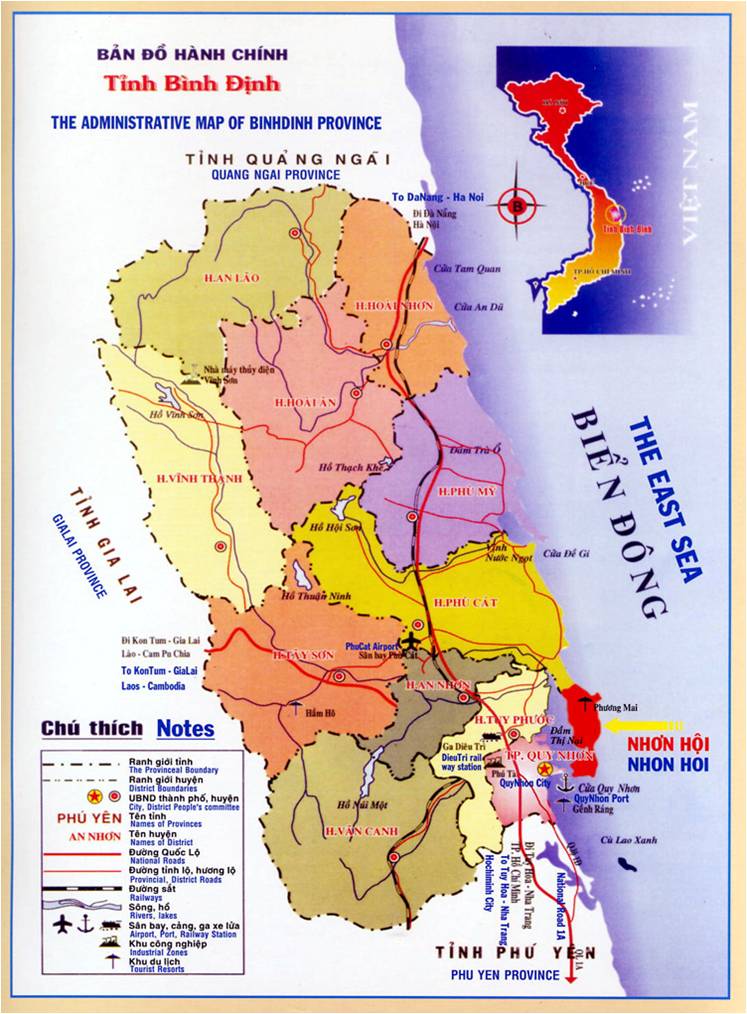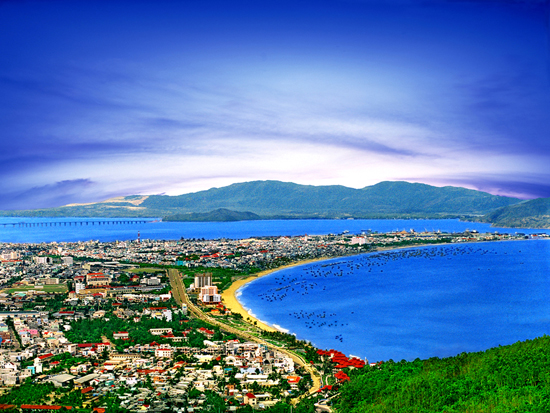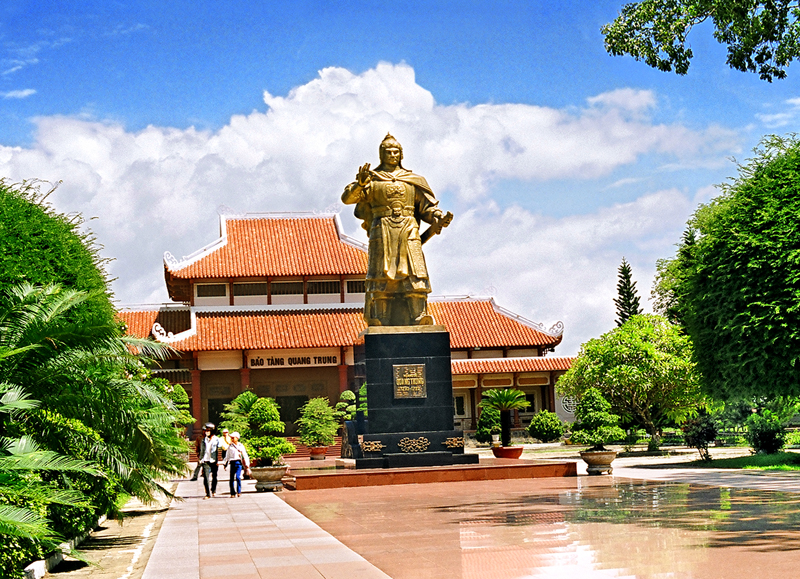HISTORY OF LAND AND PEOPLE OF BINH DINH
- Monday - 03/07/2017 11:20
- Close page
Up to now, through archeological excavations, people have identified that 2000 years ago in Binh Dinh area where there are cultural resident Sa Huynh lived. From the beginning of AD (192) on the central land of Viet Nam has formed an ancient state, the State of Champa. The State of Champa was built on a brilliant cutural basement, it inherited of Sa Huynh’s cuture, and absored Indian, Chinese and many cutures’ influences in the region. The State of Champa with its origin from 192 ended its own historical role in the last half of XVII century, ending its glorious existence during 16 centuries.
Binh Dinh is the central region of central Viet Nam with nearly 5 centuries with role of central Champa State, although there were many ups and downs, the war was ongoing, but cuture of Champa still developed untill the Champa State lost its historical role. The cutural vestiges of the Champa State existed in Binh Dinh leaving diversified in type and quantity and become important subjects for researching archeology in Binh Dinh.
In July 1471, King Le established Hoai Nhon government consisting of 3 districts: Bong Son, Phu Ly and Tuy Vien. Then, Vietnamese have started living in Binh Dinh area today. In 1490 (less than 20 years later), according to Thien Nam du ha tap said: under Hong Duc Dynasty, Hoai Nhon government had 19 districts and 100 communes.
In 1570, Nguyen Hoang, who was nominated by King Le managed Thuan Hoa and Quang Nam at that time, including Hoai Nhon government.
In 1602, Lord Nguyen Hoang changed Hoai Nhon government into Quy Nhon government.
In 1651, under Nguyen Phuc Tan Dynasty, the Lord changed Hoai Nhon government into Quy Ninh government. In 1702, Lord Nguyen Phuc Khoat reagained its name was Quy Nhon and still called during Tay Son period. In 1744, Lord Nguyen Phuc Khoat put managers, but government levels still remained. Quy Nhon was still belonged to Quang Nam, nominated ministries and directors to rule. The government was moved to the North of Do Ban citadel, located in Chau thanh village (now belonging to Nhon Thanh commune, An Nhon).
From Nguyen Lords, in the South in general, Binh Dinh in particular has had the distinction between rich and poor, different positions and classes in society. Especialy in the beginning of century XVII, the following problem was more and more deeply contradictory. Till before the Tay Son peasant uprising in 1771, in Binh Dinh had many peasant revolutions, among them typically there was revolution of Lia: stole of rich and shared for poor, punished again officials for overbearing people. But it did not last long, revolution of Lia failed.
In 1773, the Tay Son brother’s peasant revolution was led by Nguyen Nhac developed to Tay Son, occupying Kien Thanh land (now Kien My) where leaders of Tay Son were born, Nguyen Nhac called himself the first manager ruled 2 districts: Phu Ly and Bong Son. In that year (1773), Tay Son army continued to capture Quy Nhon government.
In March 1776, Nguyen Nhac made repairs and built Do Ban citadel, and renamed Emperor Palace, proclaimed King Tay Son, making gold stamp, ordaining Nguyen Lu tobe Deputy, Nguyen Hue was manager, other soldiers ordained corresponding to a new government. In 1793, after the death of King Quang Trung, Nguyen Anh conquered Emperor Palace. Nguyen Nhac was sick and asked his son- Nguyen Bao commanded resistance, Nguyen Bao’s army failed and ran away. King Quang Toan nominated Pham Cong Hung, with Nguyen Van Huan, Ngo Van So and general of navy force Dang Van Chan from Phu Xuan rescured, fought Nguyen Anh. Nguyen Anh’s army failed and ran away; Quang Toan’s army came to citadel and took treasure to cheer. Pham Cong Hung and generals ordered confiscatiing treasure and armories and occupied the city. Nguyen Nhac was angry till die.
From 1793- 1799, Emperor Palace changed into Quy Nhon city under Canh Thinh Dynasty, that was the weakening step of Tay Son.
From 1799-1802, Quy Nhon city was occupied by Nguyen Anh and changed into Binh Dinh during its history, this was the rulinf center of Nguyen Dynasty at Binh Dinh in the early years of XIX century.
In the beginning of 1885, Binh Dinh is a large province of Central Viet Nam, many parts of Gia Lai; Kon Tum belonged to Binh Dinh.
In 1907, the government of Indochina issued a decree to abolish Playcu de province. Half of this province’s land was merged into Binh Dinh province.
In 1913, French colonialism merged Phu Yen into Binh Dinh province into Binh Phu province.
In 1921, French colonialism seperated Phu Yen province, re- established Binh Dinh province and lasted untill 1945.
Along with August Revolution, on September 3rd 1945, after the uprising to get the government victory of new PPC named Binh Dinh was Tang Bat Ho province. However Tang Bat Ho province replaced for Binh Dinh province has not been recognized by Central government, on official documents did not change Binh Dinh province, so Tang Bat Ho province existed no more long.
In 9 years of resistance against the French colonialist (1945-1954), Binh Dinh was a completely biberal province, the direct strategy, backbone of the battlefield of V area, Central Highland, Southern Laos and Northeast of Campuchia. 9 hard and brave years of resistance, Binh Dinh people under the leadership of the Communist party of Viet Nam contributed together to defeat the French colonialist, forcing them to sign the Geneva Agreement to respect independence, sovereignty, unity and territorial intergrity of Vietnamese.
However, in the spirit of this Agreement, our country was temporary diveded into 2 pars: the North was liberated to bui Socialism, the South from the 17th latitude, including Binh Dinh province also under the yoke of the imperial henchmen, waiting for the general election unification of the country.
While the Geneva Agreement (1954) on Indochina was not yet executed, the US imperialists fled French and join into the South to build the government of servant Ngo Dinh Diem to make South Viet Nam becomes a new American colony.
Ngo Dinh Diem government divided the South Viet Nam into 2 regions: from Binh Thuan backward called South part; from Binh Thuan forward to the 17th latitude called Central part. The Central part divided into 2 regions, the middle of central part and the Central highland. Binh Dinh province belonged to the middle of central part and it still remained a provincial adminitrative unit until the day of liberaton of the South (April 30th 1975).
During 20 years (1954 – 1975), following the calling of President Ho Chi Minh and the central Party about struggle for liberation of the South, national reunification, army and people of Binh Dinh province have overcome countless sacrifice, hardness, brave fight, resilient the country conpletely defeated the American invader, liberated belove homeland on March 31st 1975.
From late 1975 to 1989, Binh Dinh province merged with Quang Ngai province to name Nghia Binh province. In 15 years of unification people of Binh Dinh and Quang Ngai province to overcome the consequences of war, to renovate and develop socio-economc; maitaining security and national defense, constantly improving the material and spiritual life of people.
Since 1989, Binh Dinh province was re-established again from Nghia Binh province. Since then, under the leadership of the provicial Party Committee, Binh Dinh province promotes the tradition of patriotism and revolution, Binh Dinh people have been trying to buil richer and more beautiful homeland, with many innovations in the way of thinking in economic development, making a profound change in life of everyone. A good new life in future: properity, happiness, democracy, justice and civilization have been and being builting by Binh Dinh people and whole country.
In July 1471, King Le established Hoai Nhon government consisting of 3 districts: Bong Son, Phu Ly and Tuy Vien. Then, Vietnamese have started living in Binh Dinh area today. In 1490 (less than 20 years later), according to Thien Nam du ha tap said: under Hong Duc Dynasty, Hoai Nhon government had 19 districts and 100 communes.

In 1570, Nguyen Hoang, who was nominated by King Le managed Thuan Hoa and Quang Nam at that time, including Hoai Nhon government.
In 1602, Lord Nguyen Hoang changed Hoai Nhon government into Quy Nhon government.
In 1651, under Nguyen Phuc Tan Dynasty, the Lord changed Hoai Nhon government into Quy Ninh government. In 1702, Lord Nguyen Phuc Khoat reagained its name was Quy Nhon and still called during Tay Son period. In 1744, Lord Nguyen Phuc Khoat put managers, but government levels still remained. Quy Nhon was still belonged to Quang Nam, nominated ministries and directors to rule. The government was moved to the North of Do Ban citadel, located in Chau thanh village (now belonging to Nhon Thanh commune, An Nhon).
From Nguyen Lords, in the South in general, Binh Dinh in particular has had the distinction between rich and poor, different positions and classes in society. Especialy in the beginning of century XVII, the following problem was more and more deeply contradictory. Till before the Tay Son peasant uprising in 1771, in Binh Dinh had many peasant revolutions, among them typically there was revolution of Lia: stole of rich and shared for poor, punished again officials for overbearing people. But it did not last long, revolution of Lia failed.
In 1773, the Tay Son brother’s peasant revolution was led by Nguyen Nhac developed to Tay Son, occupying Kien Thanh land (now Kien My) where leaders of Tay Son were born, Nguyen Nhac called himself the first manager ruled 2 districts: Phu Ly and Bong Son. In that year (1773), Tay Son army continued to capture Quy Nhon government.
In March 1776, Nguyen Nhac made repairs and built Do Ban citadel, and renamed Emperor Palace, proclaimed King Tay Son, making gold stamp, ordaining Nguyen Lu tobe Deputy, Nguyen Hue was manager, other soldiers ordained corresponding to a new government. In 1793, after the death of King Quang Trung, Nguyen Anh conquered Emperor Palace. Nguyen Nhac was sick and asked his son- Nguyen Bao commanded resistance, Nguyen Bao’s army failed and ran away. King Quang Toan nominated Pham Cong Hung, with Nguyen Van Huan, Ngo Van So and general of navy force Dang Van Chan from Phu Xuan rescured, fought Nguyen Anh. Nguyen Anh’s army failed and ran away; Quang Toan’s army came to citadel and took treasure to cheer. Pham Cong Hung and generals ordered confiscatiing treasure and armories and occupied the city. Nguyen Nhac was angry till die.

From 1793- 1799, Emperor Palace changed into Quy Nhon city under Canh Thinh Dynasty, that was the weakening step of Tay Son.
From 1799-1802, Quy Nhon city was occupied by Nguyen Anh and changed into Binh Dinh during its history, this was the rulinf center of Nguyen Dynasty at Binh Dinh in the early years of XIX century.
In the beginning of 1885, Binh Dinh is a large province of Central Viet Nam, many parts of Gia Lai; Kon Tum belonged to Binh Dinh.
In 1907, the government of Indochina issued a decree to abolish Playcu de province. Half of this province’s land was merged into Binh Dinh province.
In 1913, French colonialism merged Phu Yen into Binh Dinh province into Binh Phu province.
In 1921, French colonialism seperated Phu Yen province, re- established Binh Dinh province and lasted untill 1945.

Along with August Revolution, on September 3rd 1945, after the uprising to get the government victory of new PPC named Binh Dinh was Tang Bat Ho province. However Tang Bat Ho province replaced for Binh Dinh province has not been recognized by Central government, on official documents did not change Binh Dinh province, so Tang Bat Ho province existed no more long.
In 9 years of resistance against the French colonialist (1945-1954), Binh Dinh was a completely biberal province, the direct strategy, backbone of the battlefield of V area, Central Highland, Southern Laos and Northeast of Campuchia. 9 hard and brave years of resistance, Binh Dinh people under the leadership of the Communist party of Viet Nam contributed together to defeat the French colonialist, forcing them to sign the Geneva Agreement to respect independence, sovereignty, unity and territorial intergrity of Vietnamese.
However, in the spirit of this Agreement, our country was temporary diveded into 2 pars: the North was liberated to bui Socialism, the South from the 17th latitude, including Binh Dinh province also under the yoke of the imperial henchmen, waiting for the general election unification of the country.
While the Geneva Agreement (1954) on Indochina was not yet executed, the US imperialists fled French and join into the South to build the government of servant Ngo Dinh Diem to make South Viet Nam becomes a new American colony.
Ngo Dinh Diem government divided the South Viet Nam into 2 regions: from Binh Thuan backward called South part; from Binh Thuan forward to the 17th latitude called Central part. The Central part divided into 2 regions, the middle of central part and the Central highland. Binh Dinh province belonged to the middle of central part and it still remained a provincial adminitrative unit until the day of liberaton of the South (April 30th 1975).
During 20 years (1954 – 1975), following the calling of President Ho Chi Minh and the central Party about struggle for liberation of the South, national reunification, army and people of Binh Dinh province have overcome countless sacrifice, hardness, brave fight, resilient the country conpletely defeated the American invader, liberated belove homeland on March 31st 1975.

From late 1975 to 1989, Binh Dinh province merged with Quang Ngai province to name Nghia Binh province. In 15 years of unification people of Binh Dinh and Quang Ngai province to overcome the consequences of war, to renovate and develop socio-economc; maitaining security and national defense, constantly improving the material and spiritual life of people.
Since 1989, Binh Dinh province was re-established again from Nghia Binh province. Since then, under the leadership of the provicial Party Committee, Binh Dinh province promotes the tradition of patriotism and revolution, Binh Dinh people have been trying to buil richer and more beautiful homeland, with many innovations in the way of thinking in economic development, making a profound change in life of everyone. A good new life in future: properity, happiness, democracy, justice and civilization have been and being builting by Binh Dinh people and whole country.